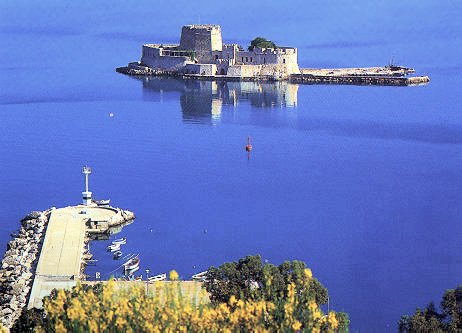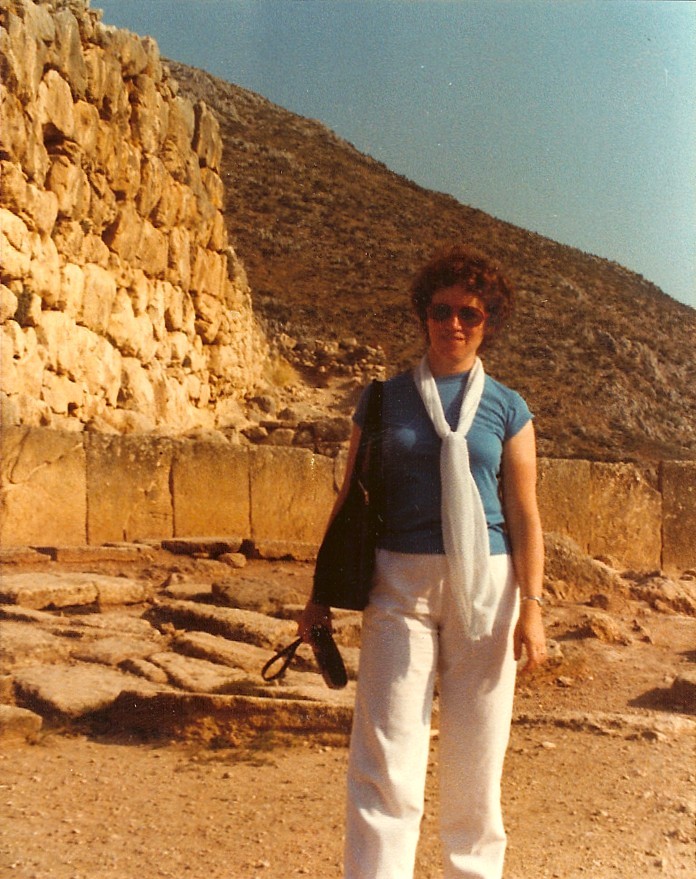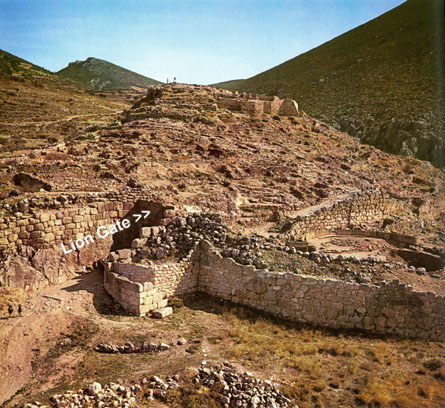|
We left Athens at 8:30 to begin our land portion of the tour, the complete circuit of which is shown on the map. Many of the places along the way were magical to me because I had already been familiar with them through the historical novels of Mary Renault, in particular The King Must Die. In fact, this part of the trip was the reverse of the path followed by Theseus: he began life as a boy in Troizen (just west of Poros in the southeast corner of the Peloponnese map below), then went on to adventures and discoveries in Epidaurus, Kenchreai, Corinth, Megara, Eleusis, and Athens (then, of course, to a lifetime of other adventures comprising the Thesian legend).

The area northwest of Athens, that around Elefsis (Eleusis) and Mégara to the east of the Isthmus of Corinth, was heavily industrialized. Chemical plants everywhere and nothing to write home about or photograph (except perhaps to demonstrate environmental pollution). Our bus took us along the Corinth highway and across the Corinth Canal where we stopped for a few minutes. While we were stopped I bought a black Greek fisherman's cap at a souvenir stand. A member of our group, Ross Reeves, later said I had started "cap mania" as nearly everyone wound up wearing them. We continued along the coast of the Peloponnese, then inland to Epidaurus (aka Epidavros). The land is quite different here from the countryside of Attica. It is forested with pine in the hills and there is much agriculture. We saw olives, citrus groves, tobacco fields. Many of the houses have tile roofs. They are square shaped and many have arbors covered with grape vines. Flowers are everywhere. Many of the houses are trimmed in shades of blue and pink.
Epidauros (Epidavros) -- We spent about an hour at Epidaurus. Reputed to be the birthplace of Apollo's son Asklepios, the healer, Epidaurus was known for his sanctuary (which was mentioned though we didn't visit it) situated about five miles from the town. It is a pleasant place, more park-like than the sites in Athens. While Christina was telling us about the place, a little local dog went to sleep with his head on the foot of a nice lady in our tour. I climbed all the way to the top of the 14,000 seat theatre, tier 55, to take some pictures. The theatre is beautifully preserved and in a lovely setting. Christina, following the ritual practiced by all tour guides, dropped a drachma at the thumele stone in the middle of the "stage"; it clinked very loudly all the way up in my top row seat. The view from up there was breathtaking.

Palamidi Castle
|


Bourtzi Fortress
|
Nauplio (Nafplion, Nauplia, Náfplio) -- We rode on to Nafplion where we will be staying the night. Nafplion is named after its founder Nafplieus, son of Poseidon. Had an outdoor lunch at a sidewalk cafe along the waterfront promenade. Karen had delicious Moussaka and I had veal with pasta -- which the Greeks call Makaponi. The waiters were quite entertaining. One carried on a soliloquy while taking down and filling the orders, while the other was using his menu to swat flies on a table out front. After lunch we went for a short walk along the waterfront. Nafplion is delightful --it doesn't seem real. And our hotel! It is new and very beautiful. Lots of straight lines, but not stark. Our room is lovely. Lots of pretty wood paneling, a coffered ceiling, and all-marble bath, automatic self-service bar (new back then), a balcony overlooking the Mediterranean. I'm having a hard time finding pictures of it on the net. One site suggests that our then-new Xenia hotel burned down to be replaced by an ultramodern establishment. It sat just below the Palamidi Castle and overlooked the Bourtzi fortress. Palamidi was fortified by the Venetians during the second Venetian occupation of the area (1686-1715); it was the location of a prison, the executioners of which lived in the Bourtzi. We were invited to climb the 999 steps up to the Castle but declined.
We learned later that the Greek government had obtained loans to build a string of these hotels. Back then it was very hard to obtain up-front money from private sources. A typical pattern for home builders was to put up a concrete shell with holes for two housing units on the bottom, two on top. Then when you had the money, complete the first unit and live in that. Then when you had enough money in hand, build the second (as a rental), and later the third, and at last the fourth. There were hundreds of these not-yet-complete structures all over Greece.
Mycenae -- Hated to leave our room, but did in order to take the excursion to Mycenae. We saw the famous beehive tomb (c. 1250 BC), then drove up to the acropolis. It is a beautiful place, situated high above the valley between two sharp bare peaks. It is very quiet and empty there. Also, being inland, it is very hot and dry.

"Tomb of Agamemnon"
|

inside the tomb
|

Mycenae Acropolis
|

cyclopean walls
|

the Lion's Gate
|

Acropolis behind Gate
|
Relaxed in our room for an hour or so, then went downstairs for a drink. We had martinis -- they come either of two ways in Greece, apparently, on ice or completely unchilled. They cost ₯ 150 each. We ordered ours unchilled out on the deck by the pool. The kid (bartender couldn't have been 16) brought out enormous cocktail glasses filled with warm Holland gin and stuffed with every kind of fruit imaginable -- noney dew melon, strawberry, canteloupe, pineapple, even a pair of green olives (I wonder if he overlooked the word "or" in his recipe book). We then had cocktails with the "Buffalo herd" (our name for those in our fairly large group from Buffalo: Chuck and Gloria Lumsden, Terry and Marian Galanis, Regis and Mary Jane Stevenson, and Jim and Joan Hurley) and dinner with the Hurleys.
Wanted to go down to the town after dinner for retzina, but we were both too tired. We tried a beer from the automatic bar (too small), then had room service deliver some. Karen conked out before she could finish hers. The embrace of Morpheus was very welcome after all we'd seen that day.
Random observations
While we were walking around the acropolis I got talking with Christina about Alexander's use of larger Scythian horses. She was amazed I knew anything at all about that. Or as she put it, "It knocks me down." She said she always assumes most American know nothing about Greeks or Greek history. She did tell me my pronunciation of Greek (learned in a high school seminary class) was "hopelessly Erasmian" (Erasmus was the one who taught Renaissance scholars how to pronounce Greek, based on his analysis of ancient poetry, and it's a far cry from modern spoken Greek today).
Christina gave me a Rex cigarette -- all Greek tobacco, not a blend; she was reacting to my Camel pack which said "Do not look for premiums or coupons as the cost of the tobaccos blended in Camel
Cigarettes prohibits the use of them." FWIW, I never met anyone who could correctly count the number of "e"s in that sentence. FYI, I quit smoking 15 Feb 1988.
We talked to Ross and Robin Reeves from Norfolk VA. He's a lawyer, she's in broadcasting. We liked them. The four of us were younger than the rest of the group.
There are mosquitoes in Nafplion but their bite isn't too bad.
The hair dryer in our room didn't work.
The girl from room service brought back change for the beer!
In the Middle Ages, the local shepherds used the so-called Tomb of Agamemnon to house their sheep.
We saw a flock of sheep on our way back from Mycenae. Also saw lots of donkeys, some loaded and working, but most resting in fields or orchards.
|










